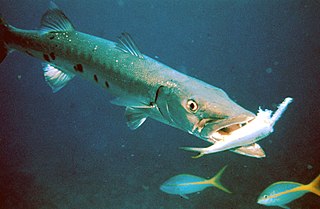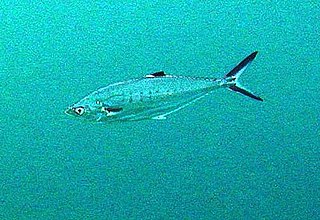
Mycteroperca bonaci, the black grouper, black rockfish or marbled rockfish, is a species of marine ray-finned fish, a grouper from the subfamily Epinephelinae which is part of the family Serranidae, which also includes the anthias and sea basses. Other fish are sometimes called the black grouper including the similar gag grouper, the misty grouper, and the warsaw grouper. This species is found in the western Atlantic Ocean from the northeastern United States to Brazil.

A barracuda is a large, predatory, ray-finned fish known for its fearsome appearance and ferocious behaviour. The barracuda is a saltwater fish of the genus Sphyraena, the only genus in the family Sphyraenidae, which was named by Constantine Samuel Rafinesque in 1815. It is found in tropical and subtropical oceans worldwide ranging from the eastern border of the Atlantic Ocean to the Red Sea, on its western border the Caribbean Sea, and in tropical areas of the Pacific Ocean. Barracudas reside near the top of the water and near coral reefs and sea grasses. Barracudas are targeted by sport-fishing enthusiasts.

Centropomus is a genus of predominantly marine fish comprising the family Centropomidae. The type species is Centropomus undecimalis, the common snook. Commonly known as snooks or róbalos, the Centropomus species are native to tropical and subtropical waters of the western Atlantic and eastern Pacific Oceans.

Dendrochirus biocellatus, the twospot turkeyfish, twinspot lionfish, twoeyed lionfish or ocellated lionfish, is a species of marine ray-finned fish belonging to the family Scorpaenidae, the scorpionfishes and lionfishes. This species is widespread throughout the tropical waters of the Indo-West Pacific region, In the wild, the species eats small fish as well as shrimp.
Scombrops oculatus, the Atlantic scombrops, is a species of marine ray-finned fish, a gnomefish from the family Scombropidae. It is found in the Western Atlantic Ocean.

The marbled parrotfish, also known as the seagrass parrotfish, is a species of marine ray-finned fish, a parrotfish from the family Scaridae and is the only known member of the genus Leptoscarus. It has a wide Indo-Pacific distribution and is also found in the southeastern Atlantic Ocean. It is a coastal species found in beds of sea grass and seaweed.

The doublespotted queenfish is a tropical game fish in family Carangidae (jacks). It is associated with reefs and ranges widely throughout the Indian and Pacific Oceans. Other common names for this fish are giant dart, large-mouthed leatherskin, leatherskin, queenfish, skinny fish, skinnyfish, St. Peter's leatherskin, white fish or whitefish. イケカツオ is in Japanese.

The yellowtail barracuda is one of the smaller species of barracuda of the family Sphyraenidae, which can be found in Indo-West Pacific oceans. It has also invaded the Mediterranean through the Suez Canal from the Red Sea, making it one of the Lessepsian migrants.

Caranx lugubris, the black jack, black trevally, black kingfish, coal fish or black ulua, is a species of large ocean fish in the jack family Carangidae. The species has a circumtropical distribution, found in oceanic, offshore waters of the tropical zones of the Pacific, Atlantic and Indian Oceans. The species is particularly prevalent around offshore islands such as the Caribbean islands in the Atlantic, Hawaii and French Polynesia in the Pacific and the Seychelles and Maldives in the Indian Ocean. Black jack are rare in shallow waters, preferring deep reefs, ledges and seamounts in clear waters. The species is easily distinguished by its black to grey fins and jet black scutes, with the head having a steep profile near the snout. The largest recorded length is 1 m and weight of 17.9 kg. The black jack lives either individually or in small schools, and is known to school with other species. It is a predatory fish, taking a variety of fish, crustaceans and molluscs as prey. Sexual maturity is reached at 34.6 cm in females and 38.2 cm in males, with spawning taking place between February and September in the Caribbean. The early life history of the species is very poorly understood. Black jack are of high importance to many island fisheries, but are rarely encountered in most continental fisheries. The species has a reputation as a gamefish, and is variably considered a terrible or excellent food fish, although several cases of ciguatera poisoning have been attributed to the species. The species was initially named Caranx ascensionis by Georges Cuvier, however several issues with the use of this name have seen Felipe Poey's name Caranx lugubris become the valid scientific name.

Hypoplectrus indigo, the indigo hamlet, is a species of marine ray-finned fish, a sea bass from the subfamily Serraninae which is part of the family Serranidae, which also includes the groupers and anthias. It is found in the central western Atlantic Ocean. It occasionally makes its way into the aquarium trade.
The northern sennet, Sphyraena borealis, is an ocean-going species of fish in the barracuda family, Sphyraenidae. It was described by the American zoologist James Ellsworth De Kay in 1842. De Kay's description was part of several volumes he published regarding the fauna of New York from 1842-1849. Northern sennet are also known as northern barracuda. While generally considered a gamefish it has only rarely been used as food by humans.
The Guachanche barracuda is an ocean-going species of game fish in the barracuda family, Sphyraenidae. It was described by the French zoologist Georges Cuvier in 1829. The description was part of the second edition of Le Règne Animal, or The Animal Kingdom. Guachanche barracuda are also known simply as guaguanche throughout much of the Caribbean. When used for food, Guaguanche barracuda are usually sold fresh or salted.

Haemulon vittatum, the boga, is an ocean-going species of grunt native to the western Atlantic Ocean. Bogas are also known as the snit in Jamaica, and bonnetmouth in the Bahamas. It was first described by Cuban zoologist Felipe Poey. This species used to be classified as Inermia vittata, but genetic data revealed that it belongs to the genus Haemulon.

The blackfin barracuda, also known as the chevron barracuda, is a species of barracuda that ranges from the Red Sea and East Africa to the Indo and Western Pacific and as far as French Polynesia.

Paroncheilus affinis, the bigtooth cardinalfish or longtooth cardinalfish, is a species of marine fish in the family Apogonidae and the only member of its genus. The bigtooth cardinalfish lives in the west-central Atlantic, off southern Florida, United States, and from the Bahamas to Venezuela, and as far south as Suriname. This species also is found in the east-central Atlantic and the Gulf of Guinea, and has been reported as far as Cape Verde. It is a pale orangeish colour.

Sphyraena helleri, the Heller's barracuda, is a schooling species of barracuda in the family Sphyraenidae.

The blackear wrasse is a species of wrasse, a type of fish in the family Labridae, from the warmer waters of the western Atlantic Ocean.

Hyporthodus mystacinus, the misty grouper, black grouper, convict grouper, eightbar grouper or moustache grouper, is a species of marine ray-finned fish, a grouper from the subfamily Epinephelinae which is part of the family Serranidae, which also includes the anthias and sea basses. It is primarily found in the Caribbean and the Gulf of Mexico with populations present around the Galapagos Islands and Central American coastlines.

Sphyraena putnamae, the sawtooth, chevron or military barracuda, is a species of barracuda found in all tropical seas and temperate waters of major oceans with the exception of the eastern pacific. It is found near shores in bays, turbid lagoons, and some reefs. A recognizable feature is the many dark chevron-shaped markings along its side, and its forked caudal fin. It spends its time in the shallow part of the sea off the coast, and stays closers to the surface levels of the open ocean. It can reach an age of 14 years old, and grow up to six feet long and over 100 pounds.

Odontoscion is a genus of marine ray-finned fish belonging to the family Sciaenidae, the croakers and drums. These fishes are found in the Western Atlantic and Eastern Pacific Oceans.
















